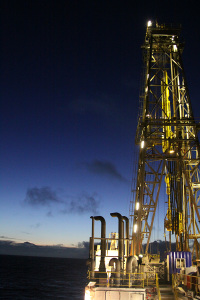Hot on the trail of the Atlantic’s birth

How hot is the Earth’s mantle, how do temperatures change over the course of millions of years and what are the possible consequences? Scientists led by Prof. Dr. Karsten Haase of the Department of Endogenous Geodynamics of GeoZentrum Nordbayern (Geo-Centre of Northern Bavaria) at Friedrich-Alexander-Universität Erlangen-Nürnberg (FAU) have uncovered important insights by looking at a period in Earth history that had long-term consequences for the planet: the break-up of what is now the Atlantic Ocean. The temperate in the Earth’s mantle was directly connected to this event as the researchers found out by analysing 340 rock samples. This investigation and its results will be presented in an online preview of the upcoming issue of Nature Geoscience 1) on Sunday, 17 March 2013.
Core samples give insight into 200 million years of Earth history
Approximately three square kilometres of new Earth crust are formed through volcanic processes annually, forming at the mid-oceanic ridges, the seams between the individual tectonic plates. Twenty cubic kilometres of liquid fused rock, also known as magma, are pushed to the surface every year, where they cool down and form the new seabed. The extent of the volcanic activity and thus the amount of magma blown out are dependent on the mantle temperature. Such changes are partly to blame for fluctuations in the global sea levels and contribute significantly to the amount of CO2 released into the atmosphere every year.
Rock samples taken from the depths of the Earth’s mantle give insight into such processes. The DFG-funded studies had core samples at their disposal taken in the Atlantic and the Pacific over the past 40 years; among others, they were collected by the US drilling ship JOIDES Resolution. Secrets from the past 200 million years of Earth history were waiting in the rock archives to be uncovered by the Erlangen scientists. The group of researchers led by Department Chair Prof. Dr. Karsten Haase consists of the research associates Dr. Marcel Regelous and Dr. Christoph Beier as well as the doctoral candidate Philipp Brandl, who is about to complete his thesis. They are all listed as authors of the publication in Nature Geoscience.

In order to decode the Earth’s message, the changes in the composition of the rock samples had to be interpreted. This led to the discovery that the Earth’s mantle was much hotter directly after the opening of the Atlantic Ocean than it is now. The temperature difference was up to 150°C and it took as long as between 60 and 70 million years for the Earth’s mantle to reach today’s ‘normal’ temperature of 1350°C beneath the Atlantic.
However, the Erlangen scientists stress that this effect is not found all over the globe. ‘Continental insulation’ means that rests of the Pangaea supercontinent prevented heat from being transported from the Earth’s interior to the surface. A similar connection between mantle temperature and the break-up of continents exists today along the Red Sea and the Gulf of Aden to the Central Indian Ridge.
Links:
- GeoZentrum Nordbayern
- Integrated Ocean Drilling Program (IODP)
1) Brandl, P.A., Regelous, M., Beier, C. & Haase, K.M. (2013): High mantle temperatures following rifting caused by continental insulation. Nature Geoscience, doi: 10.1038/NGEO1758.
Further information:
Philipp A. Brandl
Phone: +49 (0)9131 85 26068
philipp.brandl@fau.de